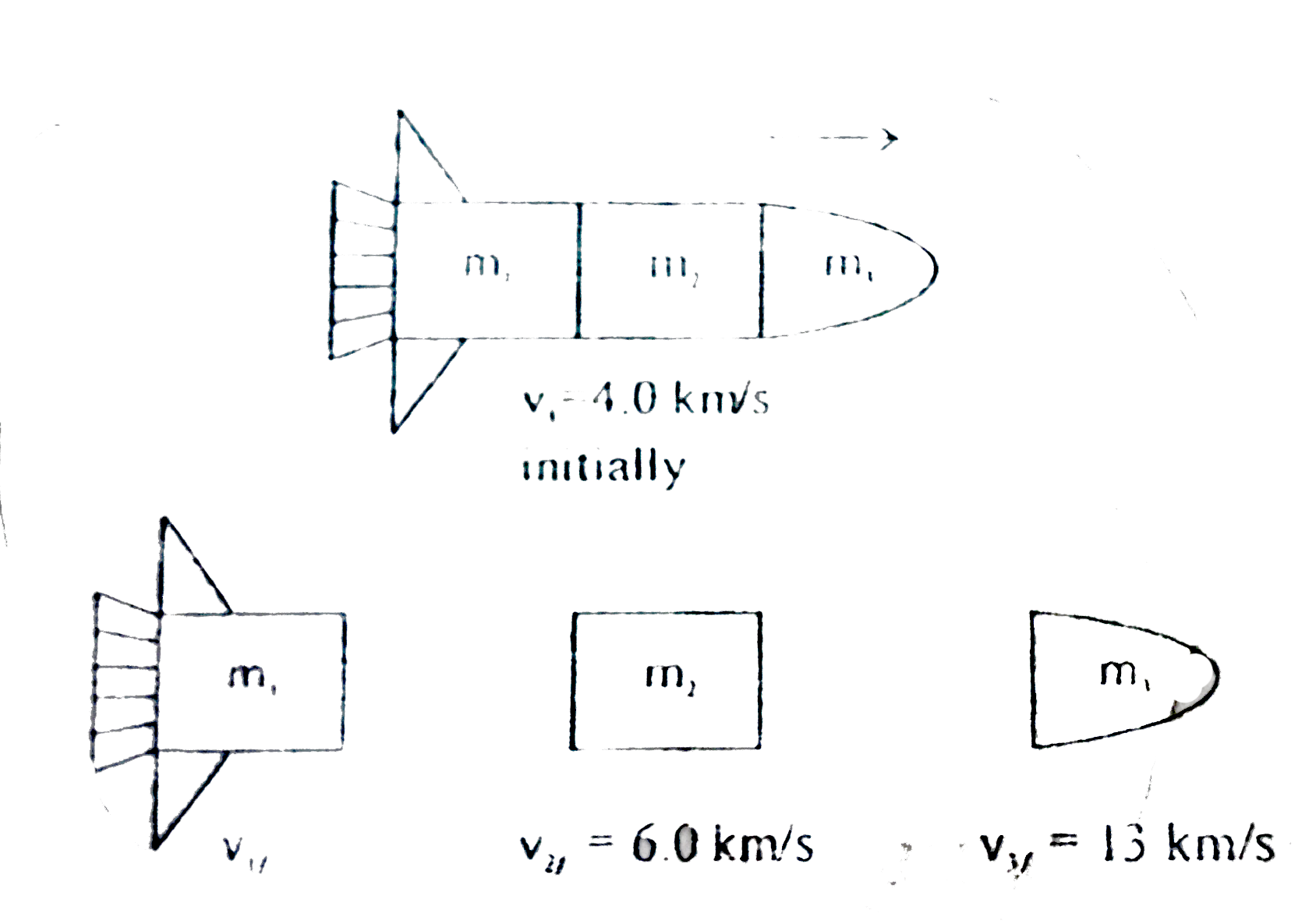A three part rocket begins intact as a single object in distant outer space, travlling to the right at 4.0km/h. The first stage (m1=950,000kg) explodes away from the rear of the rocket, with an unknown final velocity (vtf). Later, the second stage (m2=550,000kg) explodes away from teh rear with a final velocity to the right at 6.0km/s. The third stage (m2=350,000kg) ends up with a final velocity to the right of 13.0km/s. (All three move only along the x−axis . Ignore gravity. Assume that all parts of the rocket have constant masses.)

What is the final velocity (v1f) of the first stage.
919 towards left
919 towards right
917 towards left
917 towards right
The correct Answer is:A
Ans.(1)
Topper's Solved these Questions
- TEST PAPERBOOK - ALLENCHAPTER - TEST PAPEREXERCISE - PHYSICS
4 Videos
- TEST PAPERBOOK - ALLENCHAPTER - TEST PAPEREXERCISE - PHYSICS
4 Videos
- SIMPLE HARMONIC MOTIONBOOK - ALLENCHAPTER - SIMPLE HARMONIC MOTIONEXERCISE - Example
1 Videos
- TEST PAPER 1BOOK - ALLENCHAPTER - TEST PAPER 1EXERCISE - PHYSICS
11 Videos
Similar Questions
A three part rocket begins intact as a single object in distant outer space, travelling to the right at 4.0km/s. The first stage (m1=950,000kg) explodes away from the rear of the rocket, with an unknown final velocity (vtf). Later, the second stage (m2=550,000kg) explodes away from teh rear with a final velocity to the right at 6.0km/s. The third stage (m2=350,000kg) ends up with a final velocity to the right of 13.0km/s. (All three move only along the x−axis . Ignore gravity. Assume that all parts of the rocket have constant masses.)

Find the impulse received by the first rocket stage.
View SolutionA bullet of mass m and velocity v is fired into a large block of mass M. The final velocity of the system is
View Solution
Knowledge Check
A body dropped from a height h with initial velocity zero, strikes the ground with a velocity 3 m/s. Another body of same mass dropped from the same height h with an initial velocity of 4m/s. Find the final velocity of second mass with which it strikes the ground.
A3ms−1B4ms−1C5ms−1D12ms−1
A bicycle initially moving with a velocity 5.0m s−1 accelerates for 5 s at a rate of 2m s−2 . What will be its final velocity ?
View SolutionAt the beginning of the final stage of mitosis,
View SolutionA body with an initial velocity of 18 km h−1 accelerates uniformly at the rate of 9 cm s−2 over a distance of 200 m. Calculate :
(i) the acceleration in m s−2
(ii) its final velocity in m s−1.
View SolutionA mass of 1 kg is thrown up with a velocity of 100 m/s. After 5 seconds. It explodes into two parts. One parts of mass 400 g comes down with a velocity 25 m/s Calaculate the velocity of other parts:
View SolutionA mass of 1 kg is thrown up with a velocity of 100 m/s. After 5 seconds. It explodes into two parts. One parts of mass 400 g comes down with a velocity 25 m/s Calaculate the velocity of other parts:
View SolutionWhat is the wavelength of an object with mass 10,000kgs that is moving with a velocity of 10,000 cm/sec?
View SolutionA particle moving with a velocity equal to 0.4ms−1 is subjected to an acceleration of 0.15ms−2 for 2 seconds in a direction at right angles to the direction of motion. The magnitude of the final velocity is
View Solution
